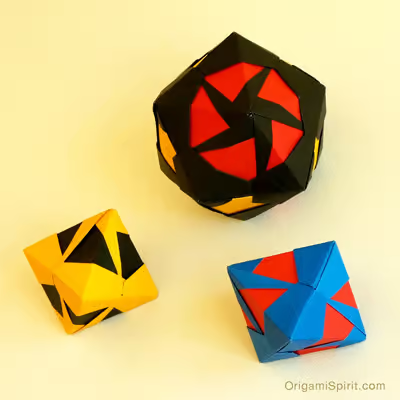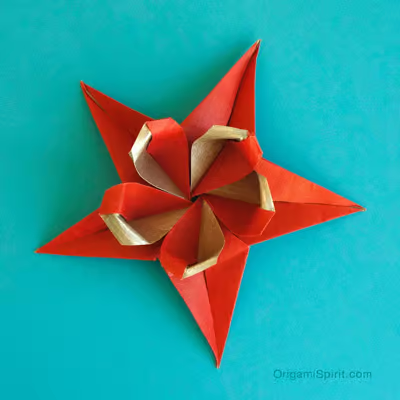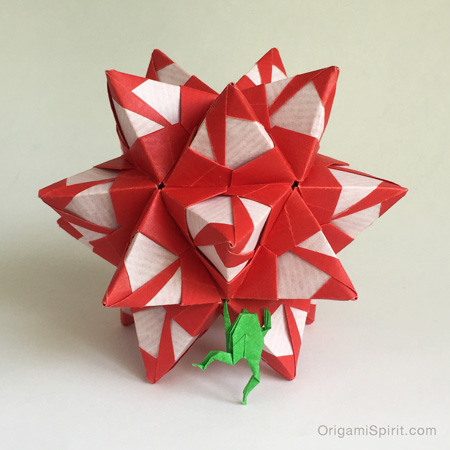When you see a picture of these kusudamas you might say “Oh that’s beautiful”. But when you actually make one and hold it in your own hands you will appreciate it all the more.
You don’t have to have a PHD in math or in art to make gorgeous modular origami pieces. Just open one of Ekaterina Lukasheva Modular Origami books (*see below) and follow her clear instructions.
Most modules are quite easy to make. Putting them together might take a little patience and perseverance, but once you finish one, you will feel a great satisfaction in the accomplishment!
If you make one of these pieces with the idea of giving it as a present you will think twice about actually letting it go, and will most likely get busy making another.
In a recent interview with Ekaterina Lukasheva, she reveals her sources of inspiration and tips to create moudular origami. Read it below.
• What led you to create your first modular origami model?
I was born into a family of scientists. My mother, father, brother, grandmother and both grandfathers have been scientists. So, in my family, if you repeat someone’s work you have nothing to be proud of. If you got this concept ‘with mother’s milk’, you will search. And the one that searches, finds.
I surely didn’t start creating origami from the very beginning. At first I could not understand how new models were created. I started modifying known units, but it never gave me the sense that I was creating something new.
By 2008 I had several glued modulars as my own models, but nothing I felt proud of. And then I suddenly found my first glue-less model. And that gave me the sense of how that happens. The magical seal was broken when I understood that “I can!”. After you understand then you can create more and more…
• How did you go about increasing your origami skills to design modular pieces in particular?
To grow any set of skills you need to have a reasonable amount of skepticism towards the work you have done previously. This is the way to turn quantity into quality. If you are not being self critical, you stagnate. No matter how many modulars you design, you can potentially end up with 100 variations of the same idea.

• Can you share with us a little about the process of designing your lovely modular pieces?
I would not say that there is a particular process. I do not, for example, sit at my table and just begin to create. Even if this strategy worked, I would probably end up with something very dull and not original. There is no recipe to follow as when you bake cookies.
I would say that this is a process without a beginning or an end. The base element –which is always present, is doodling. But it is not always the doodling that happens when faced with a clean sheet of paper. It could, for example, be doodling that occurs while folding something else.
Let’s say you walk in the forest searching for mushrooms and each step is one fold and the mushrooms represents new models. If you follow the diagram, you will surely be walking on a wide path. If you travel the wide path you are not likely to find many mushrooms. But when you decide to turn away from the path and go where you haven’t walked before, and where no one walked before you, there you are more likely to find something worthy. Later, when you have gathered some mushrooms (ideas), you can mix and match these ideas to create new dishes.
Applying this idea to origami models, I would say that when you’ve found some interesting connections, you can try doing the same with larger papers, or mixing connections with interesting design elements, or with any other variations of the same theme.
Paper choice is very important too, and the kind of paper chosen can make the model look perfect, or completely kill it. I usually procrastinate when making the paper choice as it’s that important.
• Please share with us some recommendations about paper choice for modular pieces in general.
- Avoid contrasting patterns. Yes, they look so cute when you see them in the shop, but they may spoil your creation drawing attention away from the geometry of your model and emphasize instead the pattern itself.
- I would recommend using heavy-patterned papers only for very simple modulars with little fluffy parts. And even then try mixing patterns with plain colors.
- Try not to use colors that are too bright or too dark. For example, if neon orange is chosen for the model it might look nice overall, but no one would see how cool your new model is!
- Black paper is not ideal either because details tend to disappear.
- Try to avoid mixing all the colors you have in the paper pack: blue, red, green and yellow rarely look great altogether. Limit yourself instead to a narrower gamut. Personally, I tend to choose various shades of one color.
• How do you use math concepts in creating your models?
To create a good modular I would remember the following: you need to think about beauty first, then approach the math. And when it comes to the math, people don’t always believe me, but basic geometry, high school level geometry, is quite enough for modular origami. If you understand how the right-angled triangle works and the concepts of sin, cos, tan, this is approximately 80% of what you need to know.
 Can you obtain angles of 30˚, 45˚, 60˚, 90˚ by folding the paper? This one is derived from the previous one. It’s easier to grasp these concepts by folding once than by reading about it many times. Try it ;)
Can you obtain angles of 30˚, 45˚, 60˚, 90˚ by folding the paper? This one is derived from the previous one. It’s easier to grasp these concepts by folding once than by reading about it many times. Try it ;)
And if you don’t understand then I would recommend doing a bit of studying. You can also add other concepts such as grafting, or circle packing, which are related more to origami rather than being primarily geometric.
I have seen modular pieces that are geometrically perfect, but require so many additional steps that the author is usually the last person to fold it! At the same time it’s possible to create a less ‘mathematically correct’ model that would look almost identical, but would be a pleasure to fold.
Beauty is determined not only by what a model looks like, but also how it folds. It might be an oversimplification, but in the end, who cares if a model is, for example, a perfect dodecahedron or an approximation, with the first requiring 50 steps, and the second requiring only 10 steps?
• How is the natural world of inspiration to you?
I can find inspiration from nearly any 3-dimensional object that I find beautiful. It might be a plant, a seed, an architectural form, a stellated polyhedron or an origami model. Even if it is an origami model that inspires me, I only need one detail to launch an idea for a new modular piece. One beautiful detail can be taken from an existing piece, and a tessellation made from it.
I am also inspired by beautiful color schemes found in fine pieces of art. I very much like the Japanese style of coloring found in the animated films of Hayao Miyazaki. There is some magic there! ;) That’s why I prefer folding from Japanese kami over any other kami and the availability of many unusual colors which offer intricate coloring possibilities.
The producers of Japanese kami paper even present it in an order that suggests interesting schemes… (I’m revealing a valuable little secret right here!)
I’m also inspired by ornament such as that of M.C. Escher –whose work I adore, and is work that I can look at over and over again.
• How could a school teacher use modular origami, and your books, in the classroom?
If I were a math teacher I would try to show my pupils that mathematics is beauty. Mathematics is not only the formula printed from or quoted in a book, but also something of practical use in real life.
I would show children various Archimedean solids and the possibility of building these elements using origami: a cube, an octahedron, and others.
I think it is very important for students to learn concepts using their hands rather than just hearing or reading about them. Hands on experience allows for a more comprehensive and thorough understanding.
If I were an art teacher I would use modular origami for team building. I think it might be very interesting to make something together while cultivating an understanding that everyone is contributing a little something to something greater.
The units in my books are usually quite easy so students can make 1-2 units at home. If the teacher then helps to assemble these units that would be a good example of a group working together as a team. In my experience, model assembly is much more difficult for people who have minimal experience.
*Buy the books by Ekaterina Lukasheva





Hi l have just brought 3 of you books and they are great. But l have a question in your book modern kusadama. l am am trying to do the Phoenix kusadama model but l am struggling with the last few steps and putting the units together. Is there a video anywhere of this model that l could watch to see how it is done? X April
Hi April,
You might want to ask your question directly to Ekaterina at http://kusudama.me/#/
Best wishes,
Leyla Torres